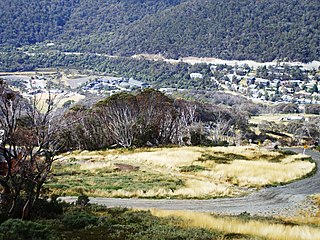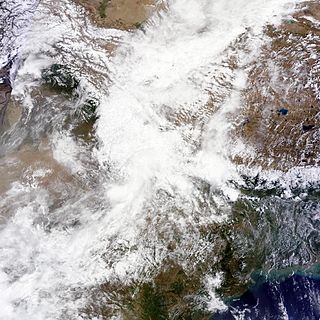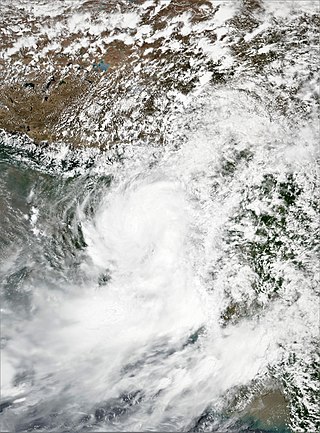Related Research Articles

The Thredbo landslide was a catastrophic landslide that occurred at the village and ski resort of Thredbo, New South Wales, Australia, on 30 July 1997. Two ski lodges were destroyed and 18 people died. Stuart Diver was the only survivor.

The Highland Towers collapse occurred on 11 December 1993 in Taman Hillview, Ulu Klang, Selangor, Malaysia. Tower Block 1 collapsed from a major landslide caused by heavy rains that burst diversion pipes. The Highland Towers consisted of three 12-storey buildings or "blocks". The collapse of Block 1 resulted in 48 deaths. Residents of the other two blocks and neighbouring establishments were evacuated due to safety concerns.

Typhoon Morakot, known in the Philippines as Typhoon Kiko, was the deadliest typhoon to impact Taiwan in recorded history. The eighth named storm and fourth typhoon of the 2009 Pacific typhoon season, Morakot wrought catastrophic damage in Taiwan, killing 673 people and leaving 26 people missing, and causing roughly NT$110 billion (US$3.3 billion) in damages. Morakot originated as a tropical depression in the West Pacific on August 2. The system initially moved northeastward, before taking a westward track, developing into a tropical storm on August 3, with the JMA giving it the name Morakot. The storm gradually strengthened as it moved towards Taiwan, intensifying into a Category 1-equivalent typhoon on August 5. Morakot reached its peak intensity on August 7, with a minimum central pressure of 945 millibars (27.9 inHg), maximum 10-minute sustained winds of 140 km/h (85 mph), and maximum 1-minute sustained winds of 150 km/h (90 mph). Afterward, Morakot's forward motion slowed and the system gradually weakened, making landfall on central Taiwan later that day as a severe tropical storm. Over the next day, Morakot slowly meandered over Taiwan, before emerging into the Taiwan Strait and turning northward, making landfall on Mainland China on August 9. Afterward, Morakot accelerated northward while gradually weakening, before later turning northeastward. On August 11, Morakot degenerated into a remnant low in the East China Sea, before dissipating on August 13, over northern Japan.

The National Disaster Response Force (NDRF) is an Indian specialised force constituted under the Disaster Management Act, 2005.
The Thekkady boat disaster occurred on 30 September 2009, when the double-decker passenger boat Jalakanyaka sank in Lake Thekkady, Periyar National Park, Kerala, India. When the boat capsized, 45 tourists died, most of them from Delhi and Kolkata. A total of 82 people were on the boat. The boat's helmsman, Victor Samuel, and another crew member were arrested on 5 October. It is the deadliest maritime accident reported in Kerala.

The 2010 Ugandan landslide occurred in the Bududa District in eastern Uganda on 1 March 2010. The landslide was triggered by heavy rain between 12 pm and 7 pm that day. At least 100 people were believed to have been killed, and 94 bodies were found.

The 1985 Puerto Rico floods produced the deadliest single landslide on record in North America, that killed at least 130 people in the Mameyes neighborhood of barrio Portugués Urbano in Ponce. The floods were the result of a westward-moving tropical wave that emerged off the coast of Africa on September 29. The system moved into the Caribbean Sea on October 5 and produced torrential rainfall across Puerto Rico, peaking at 31.67 in (804 mm) in Toro Negro State Forest. Two stations broke their 24-hour rainfall records set in 1899. The rains caused severe flooding in the southern half of Puerto Rico, which isolated towns, washed out roads, and caused rivers to exceed their banks. In addition to the deadly landslide in Mameyes, the floods washed out a bridge in Santa Isabel that killed several people. The storm system caused about $125 million in damage and 180 deaths, which prompted a presidential disaster declaration. The tropical wave later spawned Tropical Storm Isabel.

On 11 June 2012, two moderate earthquakes struck northern Afghanistan, causing a large landslide. The landslide buried the town of Sayi Hazara, trapping 71 people. After four days of digging, only five bodies were recovered and the search was called off. Overall, 75 people were killed and 13 others were injured.

In June 2013, a mid-day cloudburst centered on the North Indian state of Uttarakhand caused devastating floods and landslides, becoming the country's worst natural disaster since the 2004 tsunami. The rainfall received that month was far greater than the rainfall the state usually received. Debris blocked the rivers, causing major overflow. The main day of the flood was 16 June 2013.

On 30 July 2014, a landslide occurred in the village of Malin in the Ambegaon taluka of the Pune district in Maharashtra, India. The landslide, which hit early in the morning while residents were asleep, was believed to have been caused by a burst of heavy rainfall, and killed at least 151 people. Rains continued after the landslide making rescue efforts difficult.

On 13 December 2014, a landslide in Banjarnegara, Central Java, Indonesia, killing 93 with 23 people missing. The disaster occurred on Jemblung Village in Banjarnegara, Indonesia, at Friday, around 03.00 p.m. At the time, most of the villagers were taking a nap on their houses. The landslides also trapped some vehicles on the road. Amateur video caught the moment when a large piece of the mountain fell to the whole village. Indonesian authority said that at least around 100 people are feared dead and 300 houses were destroyed.
This is a list of notable recorded floods that have occurred in India. Floods are the most common natural disaster in India. The heaviest southwest, the Brahmaputra, and other rivers to distend their banks, often flooding surrounding areas.

On 12 June 2017, heavy monsoon rain triggered a series of landslides and floods in Rangamati, Chittagong and Bandarban - three hilly districts of Bangladesh - and killed at least 152 people. The weather also caused power cuts and telecommunications disruptions, making it difficult for rescuers to reach affected communities. Reaz Ahmed, head of Bangladesh's Disaster Management Department, said the landslides were the worst in the country's history.
A landslide occurred at about 05:38 local time on 24 June 2017 in Diexi Town, Mao County, Sichuan Province in south-western China. It destroyed 40 homes in Xinmo Village and killed 10 people, with a further 73 people missing, as of 27 June. A second smaller landslide at around 17:19 impeded rescue efforts.

The 2019 Burundi landslides were a series of rapidly occurring natural disasters in 2019. On December 4, 2019, less than two months after the October celebration of the International Day for Disaster Risk Reduction (IDDRR), heavy rains precipitated the deadly series of landslides that followed later that night into the next day, affecting a total of 9,935 people in Nyempundu, Gikomero and Rukombe of the northwestern provinces of Cibitoke, bordering Rwanda, and Bubanza as well as the northeastern province of Cankuzo. At least 27 people died and 10 remained missing per the December 11 human toll. Seven injured persons were admitted into Cibitoke referral hospital, six of whom were discharged while the seventh was transferred to the Kigobe hospital managed by Médecins Sans Frontières/Doctors Without Borders-Burundi (MSF-B). Significant property damage was incurred as well, leaving 1,081 people of 206 households displaced.

During the heavy rainfall over the monsoon period from 1 June to 18 August 2020, all 14 districts in Kerala were affected with 104 dead and 40 injured. Five districts in Kerala were flooded on 7 August 2020. Major reported incidents in relation to flooding include a landslide in Idukki district on 6 August, claiming 66 lives and an Air India plane crash that caused the death of 21 people. The 2020 flood in Kerala marked the third year in a row of severe monsoon flooding.

The 2020 Gjerdrum landslide was a quick clay landslide that occurred in the early hours of 30 December 2020 at Ask village, the administrative centre of Gjerdrum, Norway. It spanned a flow off area of 300 by 700 metres and additionally affected 9 hectares by debris flow. Several buildings were destroyed, most of them houses and apartment buildings.

The 2021 Uttarakhand flood, also known as the Chamoli disaster, began on 7 February 2021 in the environs of the Nanda Devi National Park, a UNESCO World Heritage Site in the outer Garhwal Himalayas in Uttarakhand state, India. It was caused by a large rock and ice avalanche consisting of material dislodged from Ronti peak. It caused flooding in the Chamoli district, most notably in the Rishiganga river, the Dhauliganga river, and in turn the Alaknanda—the major headstream of the Ganges. The disaster left over 200 killed or missing. Most were workers at the Tapovan dam site.
A large landslide occurred in Noney district of the Indian state of Manipur near the Tupul railway construction site on the night of 30 June 2022. It killed 58 people and three people were missing. Eighteen people were injured. Twenty-nine Indian Army personnel and 29 civilians were among the deceased. Of the missing three people, two were civilians and one was an Indian Army personnel.
On 19 July 2023 at approximately 22:30 local time, a landslide occurred in Raigad, Maharashtra, India. The landslide was caused by torrential rains, and resulted in at least 26 deaths, with more than 100 estimated trapped under debris.
References
- ↑ "Landslides in Pettimudi: social inequalities in disasters". The Hindu. 2022-09-27. ISSN 0971-751X . Retrieved 2023-08-07.
- ↑ "One year of Pettimudi landslide; a scar yet to be healed". English.Mathrubhumi. 2021-08-06. Retrieved 2023-08-07.
- ↑ "Pettimudi landslide: Memories weigh down desolate survivors". The New Indian Express. Retrieved 2023-08-07.
- ↑ "The devastating Pettimudi landslides in Kerala: Were vulnerabilities ignored?". The News Minute. 2020-08-19. Retrieved 2023-08-07.